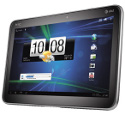Apple iPad, RIM PlayBook squeeze Android tablet share, says IDC
Sep 15, 2011 — by LinuxDevices Staff — from the LinuxDevices Archive — viewsDespite a surging worldwide tablet market that rose 89 percent in 2Q 2011, Android's share slid to 26.8 percent from the first quarter's 34.1 percent, says IDC. While Apple's iPad 2 dominated, inching up to 68.3 percent global share, RIM's PlayBook nabbed 4.9 percent, and the bargain-basement TouchPad could claim 4.7 percent in Q3, the research firm added.
Led by Apple's iPad 2, the tablet market took off in the second quarter. Worldwide shipments of tablets totaled 13.6 million units, soaring 89 percent in Q2, according to IDC. The research firm ratcheted up its 2011 tablet shipment forecast from 53.5 million units to 62.5 million, largely on the strength of the iPad.
The popular iPad 2 accounted for 9.3 million units shipped in the second quarter, comprising 68 percent of the global market, up from 65.7 percent in the first quarter. Android tablets, including those based on the Android 2.3 ("Gingerbread") build and the tablet-tailored Android 3.x ("Honeycomb"), totaled 26.8 percent, down from 34 percent from Q1, according to IDC.
 Who or what was responsible for that slide? While the iPad 2 continued strong, Research in Motion's QNX-based, seven-inch PlayBook tablet also gobbled share from Android. IDC said the PlayBook (pictured at right), which reportedly sold over 500,000 units soon after launch in April, nabbed 4.9 percent of the tablet market.
Who or what was responsible for that slide? While the iPad 2 continued strong, Research in Motion's QNX-based, seven-inch PlayBook tablet also gobbled share from Android. IDC said the PlayBook (pictured at right), which reportedly sold over 500,000 units soon after launch in April, nabbed 4.9 percent of the tablet market.
"Apple's strength and RIM's entrance meant bad news for Android-based media tablets," stated IDC.
 IDC expects HP will have sold a million units of its WebOS-based TouchPad (pictured at left) by year's end, thanks to its bargain-basement discount to $100 for the end-of-life slate. Some of those may be loaded with emerging TouchPad versions of Android, as it turns out. Android apps will also be finding their way onto the Playbook, according to RIM, although the Playbook's Android compatibility code has apparently been delayed until later this year.
IDC expects HP will have sold a million units of its WebOS-based TouchPad (pictured at left) by year's end, thanks to its bargain-basement discount to $100 for the end-of-life slate. Some of those may be loaded with emerging TouchPad versions of Android, as it turns out. Android apps will also be finding their way onto the Playbook, according to RIM, although the Playbook's Android compatibility code has apparently been delayed until later this year.
HP decided it didn't want to compete with the iPad, Android, and other players with head-starts in the tablet market. The vendor's fire sale of the TouchPad will help its Linux-based WebOS operating system claim 4.7 percent market share in Q3 before the platform share will vanish completely in 2012, says IDC.
This presumes of course that HP won't find either a buyer for WebOS or a buyer that would use the OS for tablets. HTC chairwoman Cher Wang recently said her company was at least considering acquiring WebOS. Others believe that Facebook might be a likely WebOS suitor.
Things will get worse before they get better for Android tablets, according to IDC. The platform will continue to hemorrhage market share, slipping to 23 percent in Q3 before seeing an upturn to 26 percent in Q4, says the research firm. 
IDC suggested the proliferation of "price-competitive Android products" in the market will contribute to Android's share gains. Today, most Android tablets cost between $400 and $700. The latter is the price HTC and AT&T are demanding, along with a two-year contract, for the 4G-ready HTC Jetstream (pictured).
None of the Android tablets have been able to suitably challenge the $500 iPad 2 on price, functionality, and form factor, says IDC.
All eyes are now on Amazon.com, which is expected to launch a seven-inch color slate running a custom version of Android with Amazon's content services called the Kindle Tablet. Expected to sell for $300 or less, such a product might lure some holiday shoppers Apple might otherwise claim. However, a rumored 10-inch model due in early 2012 would more clearly face off against the iPad.
The Kindle Tablet and other low-cost tablet models could change the iPad-driven dynamic over time, according to IDC analyst Jennifer Song. "Apple's iOS share will continue to lead by more than 40 percentage points over Google's Android for the remainder of the year, but we expect Apple's share to fall closer to 50 percent by the end of the forecast period as manufacturers bring new tablets to market," stated Song.
However, IDC isn't ready to classify the Kindle Tablet as, well, a tablet. IDC believes the device will be more like Barnes & Noble's Android 2.x-based Nook Color e-reader (pictured above right) than Apple's iPad 2. IDC is therefore calling the Kindle Tablet an e-reader, sight unseen.
Availability
More information on IDC's "Worldwide Quarterly Media Tablet and eReader Tracker" study may be found in this IDC announcement and this overview page.
Clint Boulton is a writer for eWEEK.
This article was originally published on LinuxDevices.com and has been donated to the open source community by QuinStreet Inc. Please visit LinuxToday.com for up-to-date news and articles about Linux and open source.